Ongoing maintenance fees are essential for the regular upkeep and management of properties, encompassing costs for repairs, cleaning, and landscaping. These fees play a crucial role in preserving property value and ensuring livability. Accurate financial forecasting of these expenses is vital for property owners to effectively manage their budgets and maintain their investments over time.
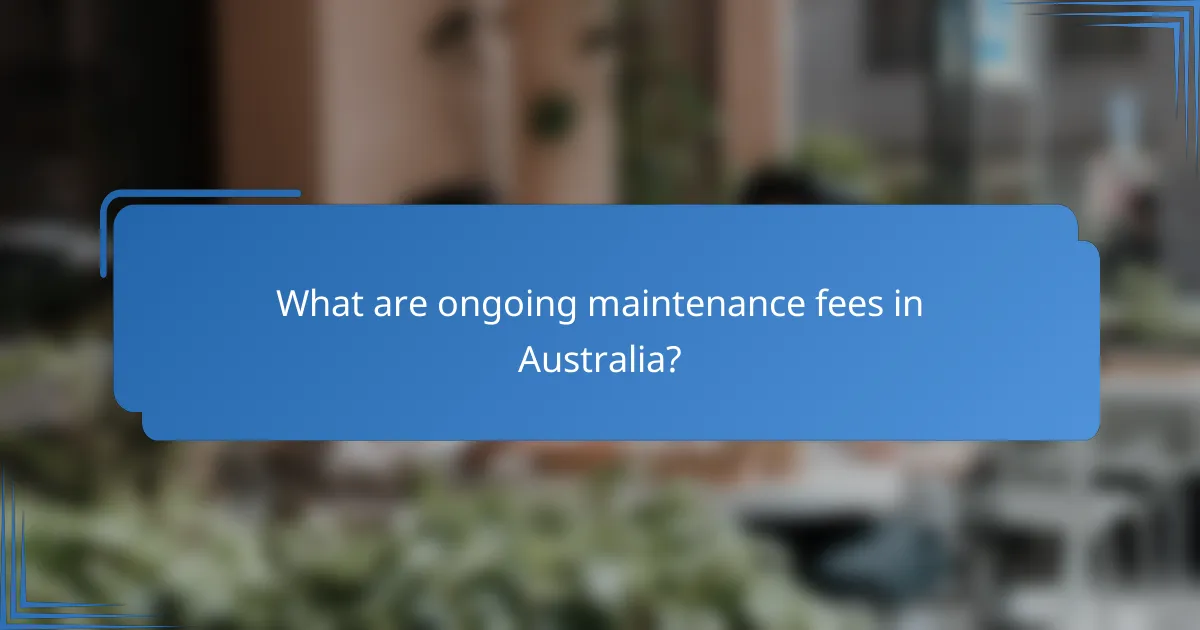
What are ongoing maintenance fees in Australia?
Ongoing maintenance fees in Australia refer to the regular costs incurred for the upkeep and management of properties. These fees can include expenses for repairs, cleaning, landscaping, and other essential services to maintain property value and livability.
Regular costs associated with property upkeep
Regular costs for property upkeep can vary significantly based on property type and location. Common expenses include routine repairs, lawn care, pest control, and cleaning services. For residential properties, homeowners might expect to pay anywhere from a few hundred to several thousand Australian dollars annually, depending on the size and condition of the property.
Additionally, properties in strata schemes may have specific fees that cover shared amenities and services, which can add to the overall maintenance costs. It’s crucial for property owners to budget for these expenses to avoid financial strain.
Typical financial forecasting for maintenance
Financial forecasting for maintenance involves estimating future upkeep costs based on historical data and property condition assessments. Property owners should consider setting aside a percentage of the property’s value each year, often recommended at around 1-2%, to cover maintenance and unexpected repairs.
Creating a maintenance schedule can help in planning and budgeting effectively. Regular inspections and timely repairs can prevent larger issues and costs down the line, ensuring that the property remains in good condition and retains its value.

How to calculate ongoing maintenance fees?
Calculating ongoing maintenance fees involves assessing the costs associated with the upkeep of a property or service over time. This typically includes regular expenses such as repairs, utilities, and management fees, which can vary based on several factors.
Step-by-step calculation process
To calculate ongoing maintenance fees, start by listing all potential costs associated with maintenance. This may include routine repairs, cleaning services, landscaping, and utility bills. Next, estimate the monthly or annual cost for each item, ensuring to account for seasonal variations in expenses.
Once you have a comprehensive list, sum these estimates to determine your total ongoing maintenance fees. For example, if your estimated costs are $200 for repairs, $100 for cleaning, and $50 for utilities, your total monthly maintenance fee would be $350.
Factors influencing maintenance fee amounts
Several factors can influence the amount of ongoing maintenance fees. Location plays a significant role; properties in urban areas may incur higher costs due to increased labor and service fees compared to rural settings. Additionally, the age and condition of the property can affect maintenance needs and costs.
Other factors include the type of property, such as residential versus commercial, and the amenities offered, like pools or landscaping. Regular assessments and adjustments to the fee structure may be necessary to reflect changes in these influencing factors, ensuring that the fees remain adequate for covering all maintenance needs.
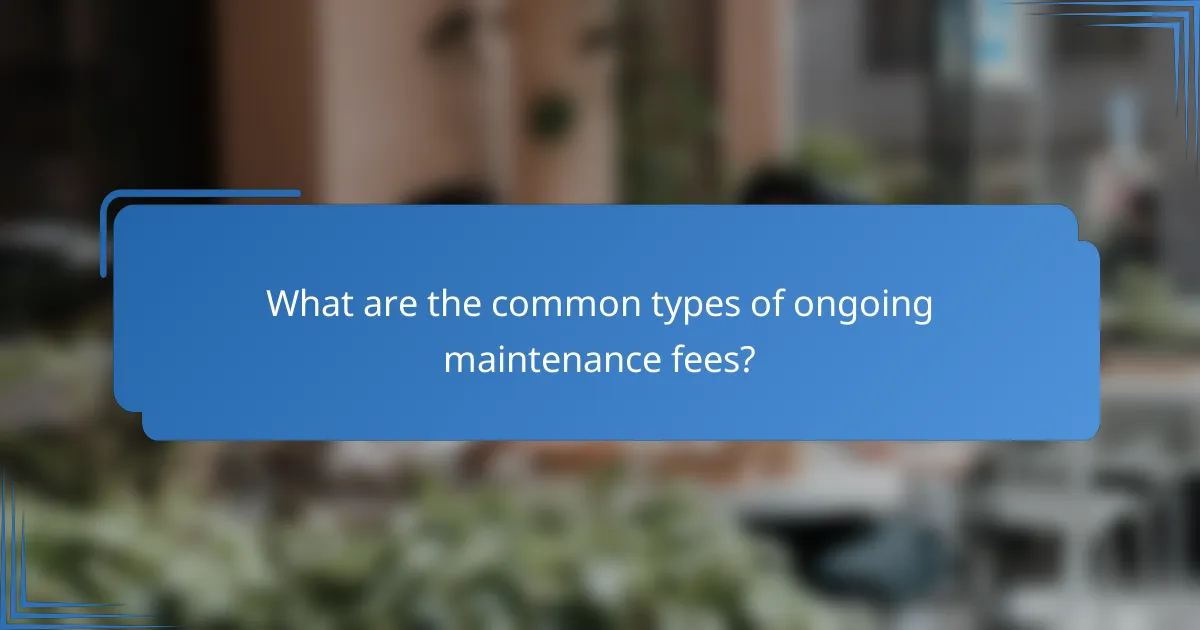
What are the common types of ongoing maintenance fees?
Ongoing maintenance fees are regular costs associated with the upkeep of properties, ensuring they remain functional and aesthetically pleasing. These fees can vary widely based on the type of property and the services required.
Property management fees
Property management fees cover the costs associated with hiring a management company to oversee a property. These fees typically range from 5% to 10% of the monthly rental income, depending on the services provided, such as tenant screening, rent collection, and maintenance coordination.
When selecting a property management company, consider their reputation, the scope of services offered, and any additional fees that may apply. It’s crucial to review contracts carefully to understand all potential costs involved.
Landscaping and gardening costs
Landscaping and gardening costs are essential for maintaining the outdoor aesthetics of a property. These expenses can vary based on the size of the property and the complexity of the landscaping, typically ranging from a few hundred to several thousand dollars annually.
Regular maintenance might include lawn care, tree trimming, and seasonal planting. It’s advisable to obtain quotes from multiple landscaping services to ensure competitive pricing and to consider seasonal contracts for cost savings.
Pool maintenance expenses
Pool maintenance expenses are necessary for keeping a swimming pool clean and safe for use. These costs can range from $100 to $300 per month, depending on the pool’s size and the level of service required, such as cleaning, chemical balancing, and equipment repairs.
Homeowners should consider setting up a regular maintenance schedule with a professional service to avoid costly repairs and ensure compliance with local health regulations. Additionally, investing in a pool cover can reduce maintenance costs by keeping debris out and minimizing chemical use.

How do ongoing maintenance fees affect property value?
Ongoing maintenance fees can significantly impact property value by influencing both resale potential and rental income. Properties with high maintenance costs may deter buyers and renters, while reasonable fees can enhance appeal and profitability.
Impact on resale value
High ongoing maintenance fees can lower a property’s resale value as potential buyers often factor these costs into their purchasing decisions. If fees are perceived as excessive, buyers may offer lower prices or avoid the property altogether.
Conversely, properties with manageable maintenance fees tend to retain or appreciate in value, as they are seen as more financially viable. It’s essential for sellers to disclose these fees upfront to avoid surprises that could derail negotiations.
Influence on rental income
Ongoing maintenance fees directly affect rental income by influencing how much landlords can charge tenants. If maintenance costs are high, landlords may need to increase rent to cover expenses, which could make the property less competitive in the market.
Landlords should aim to keep maintenance fees reasonable to attract and retain tenants. Offering amenities or services that justify these fees can help maintain rental rates while ensuring tenant satisfaction.
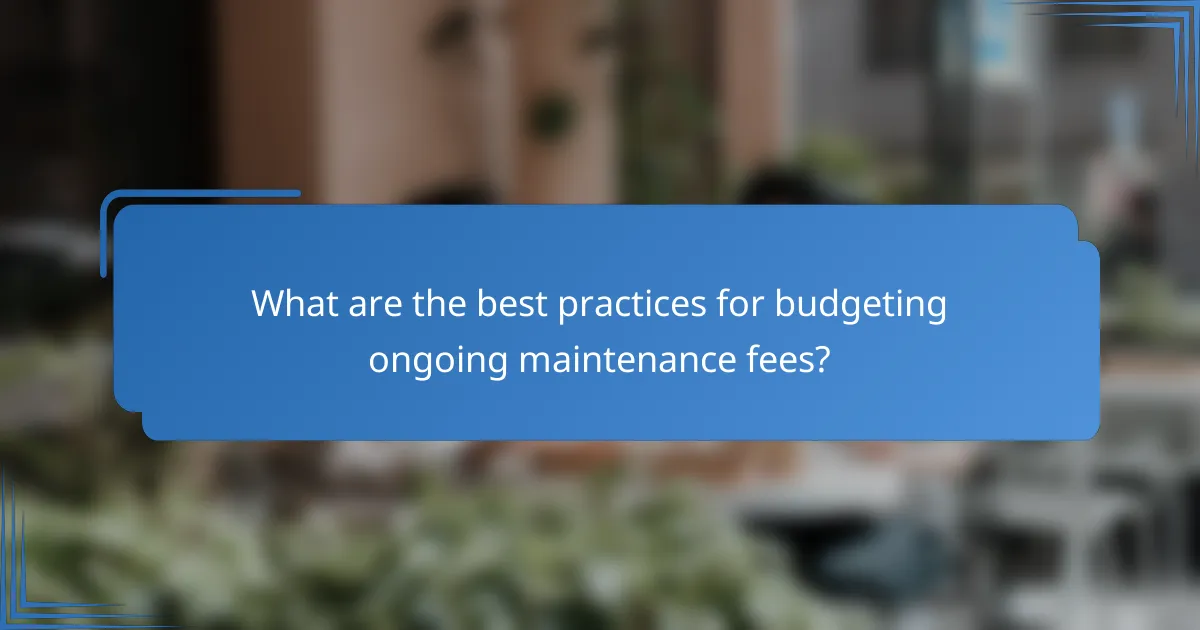
What are the best practices for budgeting ongoing maintenance fees?
Budgeting for ongoing maintenance fees involves anticipating regular costs associated with property upkeep and planning for them effectively. By establishing a clear budget and setting aside reserves, property owners can ensure they are financially prepared for both expected and unexpected expenses.
Creating a maintenance budget
To create a maintenance budget, start by assessing the property’s current condition and identifying necessary upkeep tasks. Common categories include routine repairs, landscaping, cleaning, and utilities. A good rule of thumb is to allocate about 1-3% of the property’s value annually for maintenance costs.
Break down the budget into monthly or quarterly allocations to make it easier to manage cash flow. For example, if your property is valued at $300,000, setting aside $250 to $750 per month can help cover maintenance expenses throughout the year.
Setting aside reserves for unexpected costs
Setting aside reserves for unexpected costs is crucial for effective financial forecasting. Aim to reserve 10-20% of your annual maintenance budget for unforeseen repairs, such as plumbing emergencies or roof leaks. This cushion can prevent financial strain when unexpected issues arise.
Regularly review and adjust your reserves based on the property’s age and condition. For instance, older properties may require larger reserves due to a higher likelihood of unexpected repairs. Keeping these reserves in a separate account can help ensure funds are readily available when needed.
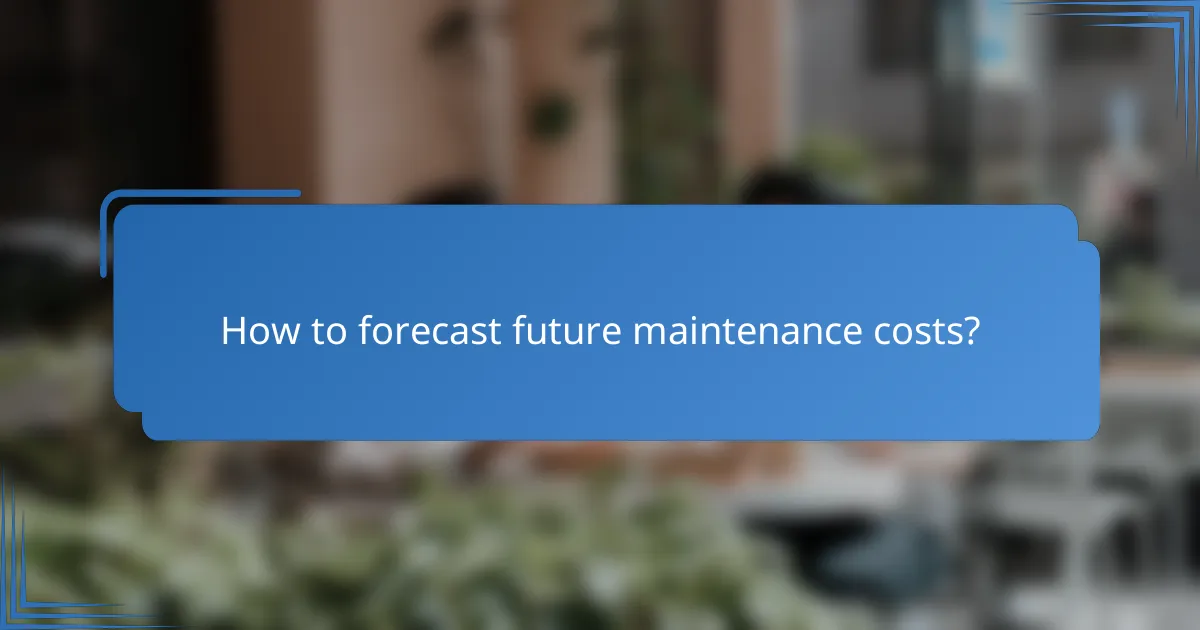
How to forecast future maintenance costs?
To forecast future maintenance costs, analyze historical expenses and consider external factors like inflation and market trends. This approach helps create a more accurate financial picture for ongoing upkeep.
Using historical data for projections
Historical data is a valuable resource for predicting future maintenance costs. Review past expenses over several years to identify patterns and average costs associated with regular upkeep. For example, if maintenance costs have increased by 5% annually, this trend can inform future budgeting.
When analyzing historical data, consider categorizing expenses into different types of maintenance, such as routine repairs, emergency fixes, and preventive measures. This breakdown allows for more precise forecasting and helps allocate funds effectively.
Incorporating inflation and market trends
Inflation significantly impacts maintenance costs, as prices for materials and labor tend to rise over time. To account for inflation, apply a reasonable percentage increase to your historical data, typically in the range of 2-3% annually, depending on current economic conditions.
Additionally, stay informed about market trends that may affect maintenance expenses. For instance, if a specific material becomes scarce or labor costs rise due to demand, these factors should be integrated into your financial forecasts. Regularly reviewing industry reports can provide insights into potential cost fluctuations.
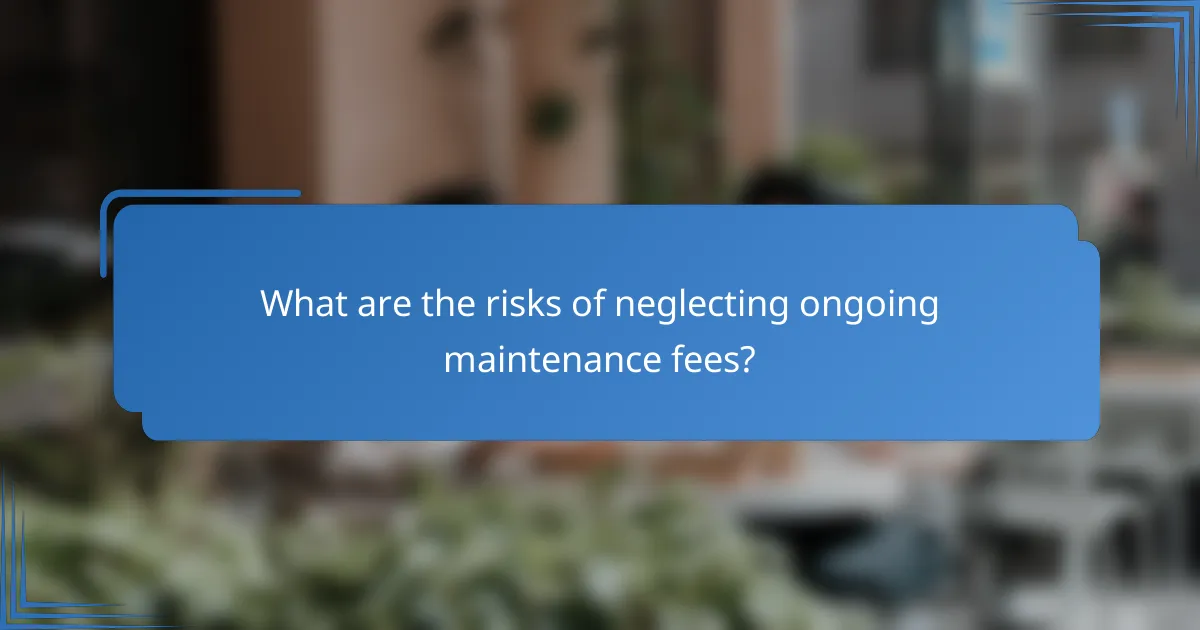
What are the risks of neglecting ongoing maintenance fees?
Neglecting ongoing maintenance fees can lead to significant financial and property-related risks. Regular upkeep is essential to avoid escalating repair costs and maintaining the overall value of your property.
Potential for increased repair costs
When ongoing maintenance fees are overlooked, minor issues can quickly escalate into major repairs. For instance, a small leak that goes unaddressed may lead to water damage, requiring costly remediation that could exceed hundreds or even thousands of dollars.
Regular maintenance helps identify problems early, allowing for budget-friendly solutions. Setting aside a percentage of your property’s value—typically around 1% to 3% annually—can help cover these ongoing costs and prevent larger expenses down the line.
Decreased property value
Failure to pay ongoing maintenance fees can result in a decline in property value. Properties that are not well-maintained may deter potential buyers, leading to lower offers or extended time on the market.
Additionally, properties with visible signs of neglect can lose value significantly, sometimes by tens of percent. To protect your investment, prioritize regular maintenance and keep detailed records of all upkeep activities, which can enhance your property’s appeal during resale.

How do ongoing maintenance fees compare across different property types?
Ongoing maintenance fees vary significantly between property types, influenced by factors such as location, size, and the services included. Generally, residential properties tend to have lower fees compared to commercial properties, which often require more extensive upkeep and management.
Residential vs. commercial properties
Residential properties typically incur lower ongoing maintenance fees, ranging from a few hundred to a couple of thousand dollars annually, depending on the amenities and services provided. Common costs include landscaping, pool maintenance, and general repairs, which are often shared among homeowners in a community.
In contrast, commercial properties face higher maintenance fees, often exceeding several thousand dollars per month. These fees cover more complex services such as janitorial work, security, and HVAC maintenance, reflecting the greater demands of business operations. For example, a small office building might see fees in the range of 10-20% of its rental income dedicated to upkeep.
When evaluating properties, consider the scope of maintenance services included in the fees. It’s crucial to review what each fee covers to avoid unexpected costs. Additionally, be aware of local regulations that may affect maintenance standards and responsibilities, particularly in commercial real estate.
